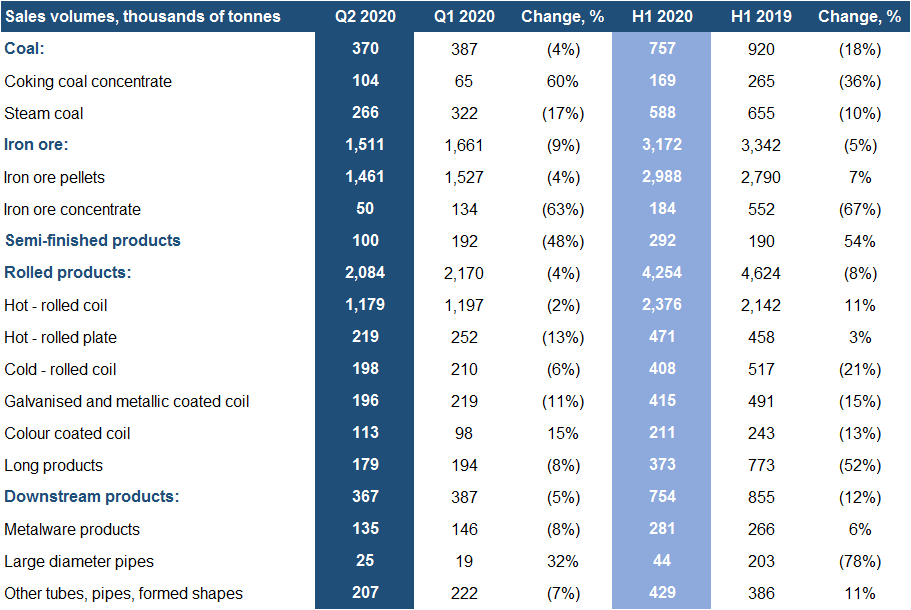July 13, 2020
PAO Severstal (MICEX-RTS: CHMF; LSE: SVST), one of the world’s leading
vertically integrated steel and steel-related mining companies, today announces
its operational results for Q2 & H1 2020.
Q2 2020 GROUP HIGHLIGHTS
- Hot metal output decreased 3% q/q to 2.33 mln tonnes in Q2 2020 (Q1 2020:
2.41 mln tonnes) due to maintenance works at BF#1, #4 and #5. - Crude steel production decreased 2% q/q to 2.81 mln tonnes in Q2 2020 (Q1
2020: 2.85 mln tonnes) as a result of the decline in hot metal output. - Consolidated steel product sales decreased 7% q/q to 2.55 mln tonnes in Q2
2020 (Q1 2020: 2.75 mln tonnes) reflecting lower crude steel production and a
higher portion of export sales, which have a longer realisation period. In
addition the Company increased stock of finished goods at the end of the
quarter. - The share of steel export shipments remained high at 44% (Q1 2020: 45%) in
response to a slowdown in domestic demand caused by lockdown measures
implemented in Russia. - The share of high value-added (HVA) products within the sales portfolio
amounted to 43% in Q2 2020 (Q1 2020: 42%), reflecting a higher level of colour
coated shipments and lower sales of semi-finished products and hot rolled
coil. - Coking coal concentrate sales volumes from Vorkutaugol increased 34% q/q to
1.28 mln tonnes in Q2 2020 as a result of planned production growth. - Iron ore pellet sales decreased 15% to 2.53 mln tonnes (Q1 2020: 2.97 mln
tonnes). In response to weaker pricing dynamics for pellets in Q2 2020,
Karelsky Okatysh reallocated a portion of its volumes into iron ore
concentrate, achieving a higher rate of end-to-end efficiency of internal
consumption at CherMK. - Iron ore concentrate sales volumes increased 30% q/q to 1.90 mln tonnes (Q1
2020: 1.47 mln tonnes) driven by production growth at Karelsky Okatysh, and a
recovery in production levels following a planned decline in Q1 at Olcon.
H1 2020 GROUP HIGHLIGHTS
- Hot metal output increased 2% y/y in H1 2020 to 4.74 mln tonnes (H1 2019:
4.67 mln tonnes) driven by reduced maintenance downtime and higher energy
efficiency rates. Crude steel production decreased to 5.66 mln tonnes (H1 2019:
6.10 mln tonnes) following the sale of the Balakovo mini-mill in 2019. - Iron ore concentrate sales volumes increased 24% y/y to 3.37 mln tonnes (H1
2019: 2.73 mln tonnes) primarily reflecting the ramp-up of the Yakovlevskiy
mine and higher production levels at Karelsky Okatysh. - Coking coal concentrate sales volumes from Vorkutaugol increased 12% y/y
driven by planned production growth. - The share of HVA products in the sales mix declined 2 ppts to 43% in H1
2020 reflecting higher sales volumes of semi-finished products and hot rolled
coil. - The average steel selling prices for H1 2020 declined from 9% to 23% across
the product range reflecting global benchmark dynamics.
Full version of the press release is on the
link.
SUMMARY OF KEY PRODUCTION, SALES VOLUMES



SEVERSTAL’S CONSOLIDATED SALES (NET OF INTERCOMPANY
SALES)

Q2 & H1 2020 ESG (ENVIRONMENTAL, SOCIAL, GOVERNANCE)
HIGHLIGHTS
- During the COVID-19 pandemic, minimising health risks to our employees is
Severstal’s key priority. Our preventive and protective measures include remote
working where possible, limiting movement around sites, sanitation and
disinfection, and temperature checking on arrival at work. We are continuing to
purchase and distribute personal protective equipment, i.e. masks, respirators,
safety glasses, hand sanitisers. - The LTIFR for H1 2020 increased by 20% y/y to 0.85 (H1 2019: 0.71). At the
same time, the number of incidents with contractors decreased to 16 in H1 2020
from 22 in H1 2019. - Tragically, there were four fatal incidents in Q1 2020: three of our staff
members and one contractor. In Q2 2020 there were no fatalities. Two of our
employees died when methane was emitted during degassing activity at the
Vorkutinskaya mine. We are investigating each of these cases in detail and
taking preventative measures to ensure that similar incidents do not take place
in the future. - At Severstal Russian Steel, total emissions of air pollutants remained
almost unchanged in H1 2020 at 142,700 tonnes (H1 2019: 142,500 tonnes). This
reflected a 2.8 times increase in the sulphur content of Olenegorsk iron ore
concentrate but also the sale of Mini-Mill Balakovo in 2019. Air pollutant
emissions per tonne of steel products increased in H1 2020 by 8% y/y to 24.9 kg
per tonne of steel. - At Severstal Resources, total emissions of air pollutants fell by 1% y/y in
H1 2020 to 99,500 tonnes (H1 2019: 100,400 tonnes).



Leave a Reply